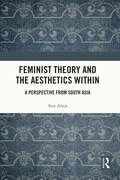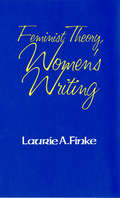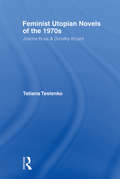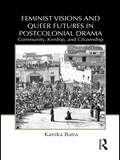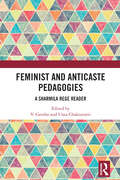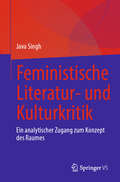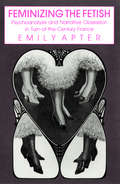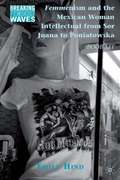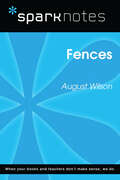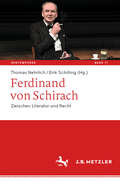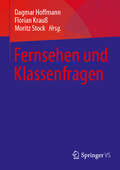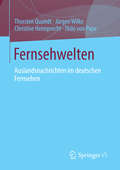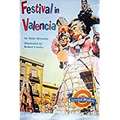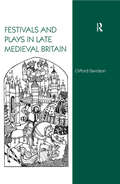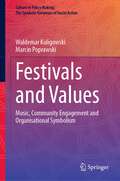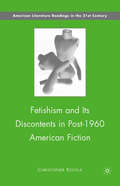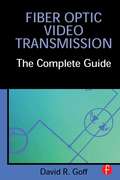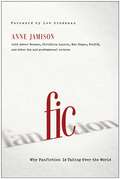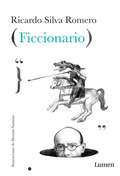- Table View
- List View
Feminist Theory Across Disciplines: Feminist Community and American Women's Poetry (Routledge Interdisciplinary Perspectives on Literature #17)
by Shira WoloskyDefying traditional definitions of public and private as gendered terms, and broadening discussion of women’s writing in relation to feminist work done in other fields, this study addresses American women’s poetry from the seventeenth to late-twentieth century. Engaging the fields of literary criticism, anthropology, psychology, history, political theory, religious culture, cultural studies, and poetics, this study provides entry into some of the founding feminist discussions across disciplines, moving beyond current scholarship to pursue an interpretation of feminism’s defining interests and assumptions in the context of women’s writing. The author emphasizes and explores how women’s writing expresses their active participation in community and civic life, emerging from and shaping a woman’s selfhood as constituted through relationships, not only on the personal level, but as forming community commitments. This distinctive formation of the self finds expression in women’s voices and other poetic forms of expression, with the aesthetic power of poetry itself bringing different arenas of human experience to bear on each other in mutual interrogation and reflection. Women poets have addressed the public world, directly or through a variety of poetic structures and figures, and in doing so they have defined and expressed specific forms of selfhood engaged in and committed to communal life.
Feminist Theory and the Aesthetics Within: A Perspective from South Asia
by Anu AnejaThis book re-examines feminist theory by looking at South Asian aesthetic conventions drawn from iconography, philosophy, Indo-Islamic mystic folk traditions and poetics. It discusses alternate fluid representations of gender and intersectional identities and interrelationships in some dominant as well as non-elite Indic aesthetic traditions. The book explores pre-Vedic sculptural and Indus terracotta iconographies; the classical aesthetic philosophy of rasa; mystic folk poetry of Bhakti and Sufi movements, and ghazal and Urdu poetics, to understand the political dimension of feminist theory in India as well as its implications for trans-continental feminist aesthetics across South Asia and the west. By interlinking pre-historic, classical, medieval, pre-modern and contemporary aesthetic and literary traditions of South Asia through a gendered perspective, the book bridges a major gap in feminist theory. An interdisciplinary work, this book will be useful for scholars and researchers of feminist theory, women’s studies, gender studies, art and aesthetics, philosophy, literature, cultural studies, queer studies, sexuality studies, political studies, sociology and South Asian studies.
Feminist Theory, Women's Writing (Reading Women Writing)
by Laurie A. FinkeIn this rewarding book, Laurie A. Finke challenges assumptions about gender, the self, and the text which underlie fundamental constructs of contemporary feminist theory. She maintains that some of the key concepts structuring feminist literary criticism need to be reexamined within both their historical context and the larger framework of current theory concerning language, representation, subjectivity, and value.
Feminist Translation Studies: Local and Transnational Perspectives (Routledge Advances in Translation and Interpreting Studies)
by Olga Castro Emek ErgunFeminist Translation Studies: Local and Transnational Perspectives situates feminist translation as political activism. Chapters highlight the multiple agendas and visions of feminist translation and the different political voices and cultural heritages through which it speaks across times and places, addressing the question of how both literary and nonliterary discourses migrate and contribute to local and transnational processes of feminist knowledge building and political activism. This collection does not pursue a narrow, fixed definition of feminism that is based solely on (Eurocentric or West-centric) gender politics—rather, Feminist Translation Studies: Local and Transnational Perspectives seeks to expand our understanding of feminist action not only to include feminist translation as resistance against multiple forms of domination, but also to rethink feminist translation through feminist theories and practices developed in different geohistorical and disciplinary contexts. In so doing, the collection expands the geopolitical, sociocultural and historical scope of the field from different disciplinary perspectives, pointing towards a more transnational, interdisciplinary and overtly political conceptualization of translation studies.
Feminist Utopian Novels of the 1970s: Joanna Russ and Dorothy Bryant
by Tatiana TeslenkoThis book presents an exploration of the reinvented utopia that provided second-wave feminists of the 1970s with a conceptual space to articulate the politics of change. Tatiana Teslenko argues that utopian fiction of this decade offered a means of validating the personal as well as the political, and of criticizing a patriarchal social order. Tesl
Feminist Visions and Queer Futures in Postcolonial Drama: Community, Kinship, and Citizenship (Routledge Advances In Theatre And Performance Studies #17)
by Kanika BatraIn this timely study, Batra examines contemporary drama from India, Jamaica, and Nigeria in conjunction with feminist and incipient queer movements in these countries. Postcolonial drama, Batra contends, furthers the struggle for gender justice in both these movements by contesting the idea of the heterosexual, middle class, wage-earning male as the model citizen and by suggesting alternative conceptions of citizenship premised on working-class sexual identities. Further, Batra considers the possibility of Indian, Jamaican, and Nigerian drama generating a discourse on a rights-bearing conception of citizenship that derives from representations of non-biological, non-generational forms of kinship. Her study is one of the first to examine the ways in which postcolonial dramatists are creating the possibility of a dialogue between cultural activism, women’s movements, and an emerging discourse on queer sexualities.
Feminist and Anticaste Pedagogies: A Sharmila Rege Reader
by Uma Chakravarti V. GeethaThis book comprises the collected essays of Sharmila Rege (1964 – 2013), which span a range of themes, including critical perspectives on women’s movements, Dalit standpoint feminism, and the relationship between Women’s Studies and other disciplines. Written over two decades and more (from the 1990s to 2010), these pioneering essays draw from the struggles and writings of Dalit women, the long history of anticaste thought in Maharashtra and global feminist debates. Equally, they address enduring concerns to do with caste and gender, and call attention to the inseparability of struggles against caste and patriarchy.Framed and annotated by an introduction that places Sharmila's work in the intellectual and historical contexts that shaped it, the volume also features short prefatory notes by her colleagues on the various themes taken up for discussion. Addressing, as it does, the researcher, the activist and the teacher, the book is indispensable for students and researchers of women’s studies, feminism, gender studies, Dalit studies, minority studies, Sociology, as well as studies in language and rhetoric.
Feministische Literatur- und Kulturkritik: Ein analytischer Zugang zum Konzept des Raumes
by Java SinghFeministische Literatur- und Kulturkritik erforscht interdisziplinäre Verbindungen zwischen Kulturanthropologie, Geographie, Psychologie und feministischer Literaturkritik, um einen theoretischen Rahmen für Raumkritik zu entwickeln. Anhand des im Buch entwickelten Rahmens der räumlichen Gynokritik werden ausgewählte Texte aus fünf verschiedenen Genres - Kurzgeschichte, Roman, Film, Zeichentrickfilm und OTT-Serie - analysiert, die von Frauen verfasst wurden. Die in dem Buch behandelten Autorinnen bilden eine transnationale Gemeinschaft von Frauen, die gemeinsame Anliegen in Bezug auf Geschlecht, Umwelt, Technologie und soziale Hierarchien teilen. Es handelt sich um eine geografisch und sprachlich vielfältige Gruppe aus Indien, Uruguay, Spanien, Argentinien und den USA. Das Buch bietet ein immenses Potenzial für eine vergleichende Studie zu zahlreichen Aspekten, von denen sich die vorliegende Arbeit auf die Behandlung des Themas Raum konzentriert und zeigt, dass räumliche Logik undGrammatik wesentliche Elemente der feministischen Praxis sind. Das Buch offenbart das ungeprüfte Potenzial der Praxis der Schöpferinnen, die zugeschriebenen Zentren, um die herum die sozialen Arrangements strukturiert sind, zu destabilisieren, zu dezentrieren und zu zerstören. Darüber hinaus bietet das Buch wertvolle Analyseinstrumente, die die Literaturtheorie, die vergleichenden Kulturwissenschaften, die vergleichende Literaturwissenschaft, die Geschlechterforschung, die feministische Kritik und die interdisziplinären Geisteswissenschaften bereichern. Es ist ein unverzichtbares Hilfsmittel für Studierende und Lehrende in diesen Studienbereichen, das es ihnen ermöglicht, Texte aus einer neuen Perspektive zu betrachten.
Feminizing the Fetish: Psychoanalysis and Narrative Obsession in Turn-of-the Century France
by Emily ApterShoes, gloves, umbrellas, cigars that are not just objects—the topic of fetishism seems both bizarre and inevitable. In this venturesome and provocative book, Emily Apter offers a fresh account of the complex relationship between representation and sexual obsession in turn-of-the-century French culture. Analyzing works by authors in the naturalist and realist traditions as well as making use of documents from a contemporary medical archive, she considers fetishism as a cultural artifact and as a subgenre of realist fiction. Apter traces the web of connections among fin-de-siècle representations of perversion, the fiction of pathology, and the literary case history. She explores in particular the theme of "female fetishism" in the context of the feminine culture of mourning, collecting, and dressing.
Femmenism and the Mexican woman intellectual from Sor Juana to Poniatowska: Boob Lit
by Emily HindHind draws on poetry, short stories, plays, novels, photographs, personal correspondence, advertising, and interviews to make visible the anti-feminine tendencies in femmenism and to imagine a femmenism that will appeal to the next generation of women.
Fences (SparkNotes Literature Guide Series)
by SparkNotesFences (SparkNotes Literature Guide) by August Wilson Making the reading experience fun! Created by Harvard students for students everywhere, SparkNotes is a new breed of study guide: smarter, better, faster.Geared to what today's students need to know, SparkNotes provides:*chapter-by-chapter analysis *explanations of key themes, motifs, and symbols *a review quiz and essay topics Lively and accessible, these guides are perfect for late-night studying and writing papers.
Ferdinand von Schirach: Zwischen Literatur und Recht (Kontemporär. Schriften zur deutschsprachigen Gegenwartsliteratur #17)
by Erik Schilling Thomas NehrlichFerdinand von Schirach war lange Strafverteidiger, bevor er mit dem Erzählband Verbrechen einen sensationellen Debüterfolg feierte. Seither hat er ein umfangreiches und vielfältiges literarisches Werk veröffentlicht. Mit über 10 Millionen verkauften Büchern und Übersetzungen in über 40 Ländern gehört Schirach zu den meistgelesenen deutschen Gegenwartsautoren. Wie erklärt sich dieser Erfolg? Was zeichnet seine Texte aus, ästhetisch, diskursiv und politisch? Die im vorliegenden Band versammelten Beiträge untersuchen Schirachs Werk aus literatur-, kultur- und rechtswissenschaftlicher Perspektive: seine Poetik, seine Medien und vor allem seine Verbindung von Literatur und Recht.
Fernsehen und Klassenfragen
by Dagmar Hoffmann Florian Krauß Moritz StockDer Sammelband untersucht das Verhältnis von Klasse – einer nicht nur ökonomischen, sondern auch kulturellen und politischen Kategorie – und dem Fernsehen in seinen gegenwärtigen hybriden Formen vor allem aus vier Perspektiven: Erstens geht es um Klassenfragen im Fernsehen, auf der Ebene der Repräsentation, zweitens um Klassenfragen des Fernsehens auf der Seite der Produktion. Hier ist zum Beispiel zu analysieren, welche Klassen welches Fernsehen (für welche Klassen) entwickelt und herstellt. Unter drittens Klassenfragen beim Fernsehen fallen Beiträge, die sich auf die Seite der Rezeption fokussieren und zum Beispiel die Lesarten zu spezifischen Klassendarstellungen beleuchten. Viertens nimmt der Band Klassenfragen der Fernsehwissenschaft in den Blick und reflektiert in diesem Zusammenhang ihre Lücken und ihre Prägung durch Klassenzugehörigkeit.
Fernsehwelten
by Thorsten Quandt Jürgen Wilke Christine Heimprecht Thilo PapeDer Band vermittelt ein eindrückliches Bild vom Stand der Auslandsberichterstattung im deutschen Fernsehen. Auf der Basis inhaltsanalytischer Untersuchungen, einer Repräsentativbefragung unter deutschen Fernsehzuschauern sowie Leitfadeninterviews mit Journalisten aus den produzierenden Redaktionen werden die Erkenntnisse eines umfassenden Projekts zur Erforschung der Auslandsnachrichten im deutschen Fernsehen diskutiert.
Festivals and Plays in Late Medieval Britain
by Clifford DavidsonBased in records and iconography, this book surveys medieval festival playing in Britain more comprehensively than any other work to date. The study presents an inclusive view of the drama in the British Isles, from Kilkenny to Great Yarmouth, from Scotland to Cornwall. It offers detailed readings of individual plays-including the York Creed Play, Pentecost and Corpus Christi plays and the little studied Bodley plays, among others - as well as a summary of what is known of their production. Clifford Davidson here extends the usual chronological range to include work typically categorized as early modern, enabling a juxtaposition of earlier plays with later plays to yield a better understanding of both. Complementing documentary evidence with iconographic detail and citation of music, he pinpoints a number of common misconceptions about medieval drama. By organizing the study around the rituals of the liturgical seasons, he clarifies the relationship between liturgical feast and dramatic celebration.
Festivals and Values: Music, Community Engagement and Organisational Symbolism (Culture in Policy Making: The Symbolic Universes of Social Action)
by Waldemar Kuligowski Marcin PoprawskiThis is an original book, covering all the past areas of research anyone would need to know about festivals and ‘event-based culture’. It is based on academic research but written in a way relevant for cultural professionals – uniquely explaining the cultural power of festivals, and with original empirical research, the realities of organisation and management, and social and economic value. Dr Jonathan Vickery, Reader in Cultural Policy Studies and Director: Centre for Cultural and Media Policy Studies, Univeristy of Warwick.This book discusses music festivals in the context of the specific values they convey. Today, music festivals are a permanent feature of national, regional and local cultural policies, a valuable asset in the tourism industry and a significant source of income for an industry that has been adversely affected by the steady decline in physical sales of music. For the audience, on the other hand, it is an opportunity to escape from everyday life, multi-sensory contact with art, an activity that stands for “full-body participation”– a cultural phenomenon that drags people out of their homes like no other. There is one common denominator linking the above-mentioned features of contemporary music festivals – namely the world of values. This is evident from the non-accidental locations, festivals spaces’ design, planning and the line-ups created consciously, with great care. The organisers’ “missions”, logos, and other symbolic organisational artefacts communicate specific values. These values are explicitly mentioned by artists and audiences: they can be easily identified in online forums and media reports; participant behaviour, festival “rituals” and additional festival programs are shaped on the basis of values, and cooperation is built between the festival and the local community. As the reader will quickly realize, numbers and statistics sit alongside descriptions and quotations in this book, and the organisers’ statements are accompanied by the opinions of academics, but above all the festival audience is given a voice – both through quotations and their drawings. This voice is by no means uniform, as it turned out that research into values was often transformed into a pretext for spinning tales about one’s life situation, one’s political preferences, and one’s understanding of freedom and responsibility. Memories were mixed with declarations, joy with regret, curses with dreams, prose with poetry. Thomas Pettitt was not wrong in noting that “Social history has learnt to appreciate festival as a valuable window on society and its structures”. The authors have tried to open all the windows available. Students and researchers in the fields of cultural anthropology, social psychology, folklore studies, comparative religion, sociology of culture, cultural policy, cultural history, and cultural management will find this book highly interesting.
Fetishism and Its Discontents in Post-1960 American Fiction
by Christopher KocelaThis study explores the concept of fetishism as a strategy for expressing social and political discontent in American literature, and for negotiating traumatic experiences particular to the second half of the twentieth century.
Fever Hospital: A History of Fairfield Infectious Diseases HospitaL
by W K AndersonInfectious diseases have threatened life and social order throughout human history, inducing deep and pervasive fear. The story of Fairfield Hospital is central to the story of infectious diseases in Victoria, and is thus a significant chapter in Australia's history. Fairfield Infectious Diseases Hospital began life in 1904 as a fever hospital. It treated patients for typhoid, diphtheria, cholera and smallpox, and grappled with epidemics of polio and scarlet fever. It later became one of the world's foremost centres for the research and treatment of infectious diseases, especially HIV/AIDS. And then it was closed, in 1996, amid controversy, protest and distress. Fever Hospital is an invaluable record of the work and achievements of Fairfield. W. K. Anderson sets these achievements in the context of Australian developments in medicine and health. He describes important initiatives in research, medical treatment and patient care. He traces a century of change in organisational structure and personnel. The combined expertise of the Fairfield Hospital team is now scattered. But Anderson, in gathering together the fruits of their knowledge, experience and skill, has ensured that the story of a remarkable and much-loved hospital is not lost to us. Fever Hospital is a valuable social and institutional history. But above all it is a faithful, tangible and generously illustrated record of a great hospital, written for the people who worked at Fairfield and for those who found healing and comfort there.
Fiber Optic Reference Guide: A Practical Guide To The Technology
by David GoffThe Fiber Optic Reference Guide offers readers a solid understanding of the principles of fiber optic technology, especially as it relates to telecommunications, from its early days to developing future trends. Using a minimum of jargon and a wealth of illustrations, this book provides the underlying principles of fiber optics as well as essential practical applications. The third edition is updated to include expanded sections on light emitters, semiconductor optical amplifiers, Bragg gratings, and more systems design considerations. Fiber optics plays a key role in communications, as well as in broadcast and cable systems. Engineers working with fiber optics as well as newcomers to the industry will find the third edition of this reference guide invaluable. It will help the reader develop a solid understanding of the underlying principles of this rapidly changing technology as well as its essential practical applications. The text is thoroughly indexed and illustrated.
Fiber Optic Video Transmission: The Complete Guide
by David GoffFiber Optic Video Transmission: The Complete Guide is the only comprehensive reference to the techniques and hardware required to transmit video signals over optical fiber. As the broadcast industry moves to HDTV and enhanced television standards become the norm, fiber will become the medium of choice for video transmission, and this book is the essential guide to transmitting video over fiber optic cables. From the most basic video signal to complex multi-channel high definition video, this book details the methods of encoding video signals (including AM, FM, and digital encoding), the advantages and disadvantages of all encoding methods, and the expected performance of each method. A discussion of the the fiber optic components - such as lasers, LEDs, detectors, connectors, and other components - that are best for video transmission applications is also included. A glossary of terms, appendices of standards and publications, and a complete index round out this comprehensive guide.
Fic: Why Fanfiction Is Taking Over the World
by Anne JamisonWhat is fanfiction, and what is it not? Why does fanfiction matter? And what makes it so important to the future of literature? Fic is a groundbreaking exploration of the history and culture of fan writing and what it means for the way we think about reading, writing, and authorship. It's a story about literature, community, and technology—about what stories are being told, who's telling them, how, and why. With provocative discussions from both professional and fan writers, on subjects from Star Trek to The X-Files and Buffy the Vampire Slayer to Harry Potter, Twilight, and beyond, Fic sheds light on the widely misunderstood world(s) of fanfiction—not only how fanfiction is transforming the literary landscape, but how it already has. Fic features a foreword by Lev Grossman (author of The Magicians) and interviews with Jonathan Lethem, Doug Wright, Eurydice (Vivean Dean), and Katie Forsythe/wordstrings. Cyndy Aleo (algonquinrt; d0tpark3r) V. Arrow (aimmyarrowshigh) Tish Beaty (his_tweet) Brad Bell Amber Benson Peter Berg (Homfrog) Kristina Busse Rachel Caine Francesca Coppa Randi Flanagan (BellaFlan) Jolie Fontenot Wendy C. Fries (Atlin Merrick) Ron Hogan Bethan Jones Christina Lauren (Christina Hobbs/tby789 and Lauren Billings/LolaShoes) Jacqueline Lichtenberg Rukmini Pande and Samira Nadkarni Chris Rankin Tiffany Reisz Andrew Shaffer Andy Sawyer Heidi Tandy (Heidi8) Darren Wershler Jules Wilkinson (missyjack) Jen Zern (NautiBitz)
Ficcionario
by Ricardo Silva RomeroTreinta y cinco definiciones sobre la ficción y el drama de uno de los autores colombianos más importantes de la actualidad. "Puede ser que las cosas pasen porque sí, pero yo me he jugado la vida por el drama. He creído, porque en algo hay que creer, que todo sucede por algo y para algo. Y que cada historia del mundo puede ser contada en tres actos". Ricardo Silva Romero Lo primero que el lector debe saber sobre este Ficcionario es que no es, precisamente, un libro de ensayos sobre literatura. Sí es, en cambio, una colección de respuestas a treinta y cinco sospechas que Ricardo Silva Romero ha venido despejando a lo largo de su vida como escritor, sobre las formas en las que el drama -o la ilusión de que todo tiene sentido- está presente en la vida y en las distintas manifestaciones del arte. A modo de bestiario de la ficción, y con ilustraciones de Hernán Sansone para abrir cada capítulo, aquí el autor realiza un inventario de sus pasiones -el cine de Alfred Hitchcock, de Martin Scorsese, de Woody Allen, de Mike Nichols; la literatura de Alejandro Dumas, de Paul Auster, de los hermanos Grimm; la poesía de César Vallejo; la música de Paul Simon, entre muchas otras-, que ejemplifican de manera brillante una amplia gama de temas relacionados con las decisiones que hay detrás de cada historia y de cada personaje. Escrito con un profundo respeto por el oficio, Ficcionario es un libro esencial para lectores, espectadores, directores, escritores o cualquier persona interesada en descifrar el arte de contar historias.

